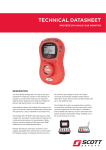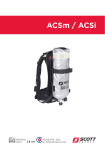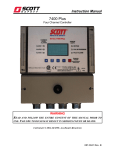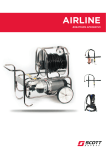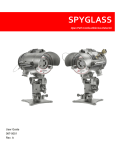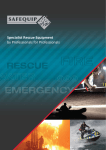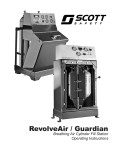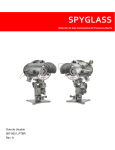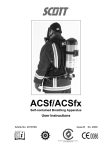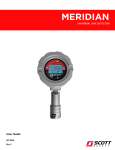Download Eagle Attack - User Manual
Transcript
SCOTT EAGLE ATTACK THERMAL IMAGING CAMERA AND CHARGING SYSTEM OPERATING AND MAINTENANCE INSTRUCTIONS WARNING USE OF THIS THERMAL IMAGING CAMERA MUST BE PART OF A COMPLETE TRAINING PROGRAM. INTERPRETATION OF THE THERMAL IMAGE REQUIRES TRAINING AND EXPERIENCE. DO NOT USE THE EAGLE ATTACK THERMAL IMAGING CAMERA IF YOU HAVE NOT BEEN THOROUGHLY TRAINED IN ITS USE AND OPERATION. USE OF THIS DEVICE WITHOUT PROPER TRAINING AND UNDERSTANDING OF ITS OPERATION MAY CAUSE ERRORS IN JUDGEMENT BASED ON MISINTERPRETATION OF THERMAL IMAGING INFORMATION WHICH MAY RESULT IN SERIOUS INJURY OR DEATH. © 2012 Scott Safety. SCOTT, the SCOTT SAFETY Logo, Scott Health and Safety, and EAGLE ATTACK are registered and/or unregistered marks of Scott Technologies, Inc. or its affiliates. EAGLE ATTACK THERMAL IMAGING CAMERA OPERATING AND MAINTENANCE INSTRUCTIONS CONTENTS DESCRIPTION...................................................................................... 2 OPTIONS / ACCESSORIES................................................................. 4 OPERATIONAL ENVIRONMENT......................................................... 4 PERFORMANCE PARAMETERS......................................................... 4 RADIO FREQUENCY INTERFERENCE (RFI)..................................... 5 THEORY OF OPERATION.................................................................... 6 BATTERY CHARGING SYSTEM.......................................................... 8 BATTERY SAFETY WITH THE LITHIUM-ION BATTERY PACK......... 9 USE OF THE CHARGING SYSTEM................................................... 10 BATTERY INSTALLATION ................................................................ 12 USING THE EAGLE ATTACK THERMAL IMAGING CAMERA......... 14 THE DISPLAY SCREEN..................................................................... 17 TEMPERATURE INDICATOR............................................................. 18 THERMAL VIDEO RECORDER OPTION........................................... 20 RECORDING VIDEO...................................................................... 21 SAVING THE VIDEO FILES............................................................ 22 VIEWING OR EDITING VIDEO FILES............................................ 23 FLASHLIGHT ACCESSORY.............................................................. 24 LANYARD ACCESSORY.................................................................... 24 INSTALLATION OF THE CHARGING SYSTEM IN A VEHICLE..................................................................................... 25 REGULAR INSPECTION.................................................................... 26 MAINTENANCE.................................................................................. 27 CLEANING.......................................................................................... 27 STORAGE........................................................................................... 27 REPLACEMENT PARTS.................................................................... 28 BATTERY BRACKET AND CLIP.................................................... 28 LENS BOOT.................................................................................... 29 DISPLAY BOOT.............................................................................. 29 LENS REPLACEMENT................................................................... 30 LIMITED WARRANTY......................................................................... 32 Page 1 of 32 P/N 595224-01 Rev E 7/12 WARNING THERMAL IMAGING CAMERAS HAVE UNIQUE OPERATING CHARACTERISTICS. THEY ARE NOT NIGHT VISION CAMERAS. THE THERMAL IMAGE REPRESENTS THE RELATIVE TEMPERATURES OF OBJECTS AND DOES NOT DEPICT WHAT THE HUMAN EYE NORMALLY SEES. INTERPRETATION OF THE THERMAL IMAGE REQUIRES TRAINING AND EXPERIENCE. DO NOT USE THE EAGLE ATTACK THERMAL IMAGING CAMERA IF YOU HAVE NOT BEEN THOROUGHLY TRAINED IN ITS USE AND OPERATION. DO NOT USE THE EAGLE ATTACK THERMAL IMAGING CAMERA IF IT STOPS OPERATING OR OPERATES INCORRECTLY. USE OF THIS DEVICE WITHOUT PROPER TRAINING AND UNDERSTANDING OF ITS OPERATION MAY CAUSE ERRORS IN JUDGMENT BASED ON MISINTERPRETATION OF THERMAL IMAGING INFORMATION WHICH MAY RESULT IN SERIOUS INJURY OR DEATH. DESCRIPTION The SCOTT EAGLE ATTACK Thermal Imaging Camera is a lightweight, highly durable infrared imaging device that can provide vision enhancement in fire fighting and similar emergency response activities. It is a rugged hand held unit with simple controls that uses highly sensitive technology capable of recognizing small differences in temperature. The EAGLE ATTACK Thermal Imaging Camera “sees” temperature differences (infrared radiation) rather than visible light. The camera is available in two versions: – The GRAYSCALE mode display version shows only shades of gray from black to white. Warmer objects appear on the display screen as lighter gray to white images while cooler objects appear darker gray to black. The EAGLE ATTACK Thermal Imaging Camera operates in two temperature ranges, a Lower and an Upper range. When viewing hotter objects at temperatures above approximately 200 °F / 93 °C, the EI icon will appear in the display indicating that the Upper range is in operation. – The TAC (Temperature Awareness Colorization) mode version displays shades of gray the same as the GRAYSCALE mode, but objects or areas at elevated temperatures appear as colors. This version may be an aid in helping fire fighters find sources of extreme heat. The approximate temperatures at which the colors appear are as follows: 200 °F to 500 °F (93 °C to 260 °C) – shades of Yellow 501 °F to 800 °F (261 °C to 426 °C) – shades of Orange 801 °F to 1200 °F(427 °C to 649 °C) – shades of Red The power controls consist of one glove accessible POWER button just below the display screen which controls power ON/OFF. The display provides information including battery status and over temperature warning. A digital temperature indicator on the display screen gives the approximate temperature of the target area at the center of the display. The temperature is determined by an average of points within the target area. The temperature indicator is available from the factory as either degrees Fahrenheit or Celsius. The Lithium-ion (Li-Ion) battery is capable of powering the unit approximately 5 hours (3.5 hours with TVR). A battery power gauge appearing in the display is standard. The EAGLE ATTACK Charging System holds the camera and charges both the battery installed in the camera as well as a second spare battery. The battery charger may be used on a desk top or may be mounted on the wall or in a vehicle. For vehicle mounting, the charger may be powered by a 12 volt adapter or may be hard wired into the vehicle with either 12 or 24 volt supply. In addition, two charging stations may be wired together and powered from a single AC adapter or up to three units may be wired together if using the 12 VDC adapter or 12 or 24 VDC source power from a vehicle. The EAGLE ATTACK Thermal Imaging Camera is available with a black housing with a choice of outer boots in bright RED, BLACK, YELLOW, or ORANGE. Page 2 of 32 P/N 595224-01 Rev E 7/12 The EAGLE ATTACK Thermal Imaging Camera may be equipped with an optional builtin Thermal Video Recorder that records up to 250 minutes of continuous video from the camera display. This video can be downloaded to a standard Personal Computer (PC) using a USB 2.0 cable, SCOTT P/N 31002216, and Power Supply, SCOTT P/N 31002284. An optional heavy duty three foot long retractable lanyard is available. An optional glare shield and rail-mount flash light are also available. The lens is covered by a replaceable high impact cover that is chemical, water, and heat resistant. An optional Glare Shield version of the Display Boot is available. Instructions for all optional features are contained in this manual. Use and maintenance of this instrument must be part of a complete thermal imaging camera training program. The following procedures shall be used to operate and maintain the unit prepared for emergency use. The unit shall be inspected after each use. There are no user serviceable parts inside the camera except as outlined in this instruction. If any malfunction is noted, remove the unit from service and return to SCOTT Safety or an authorized SCOTT Safety Service Center for repair. The EAGLE ATTACK Thermal Imaging Camera is not a night vision camera. Although this device can significantly enhance vision in certain situations, the user must never become wholly dependent on the unit for personal navigation. Always maintain awareness of location and escape routes when using this device. Do not use the EAGLE ATTACK Thermal Imaging Camera in situations where a dedicated infrared thermometer, a pyrometer, or a radiometer is required. WARNING READ AND UNDERSTAND THIS ENTIRE MANUAL. TRAINING IS REQUIRED BEFORE USE OF THIS EQUIPMENT IN A HAZARDOUS SITUATION. THE TRAINING MUST INCLUDE EXTENSIVE PRACTICE WITH THE THERMAL IMAGING CAMERA IN A VARIETY OF ENVIRONMENTS AND A COMPLETE UNDERSTANDING OF HOW TO INTERPRET THE THERMAL IMAGE. BECAUSE DIFFERENT BRANDS AND MODELS OF THERMAL IMAGING CAMERAS MAY OPERATE DIFFERENTLY, ALWAYS UPDATE TRAINING WITH EACH NEW PIECE OF EQUIPMENT. USE OF A THERMAL IMAGING CAMERA WITHOUT PROPER TRAINING MAY PLACE THE USER AT HIGHER RISK IN DANGEROUS SITUATIONS WHICH COULD RESULT IN SERIOUS INJURY OR DEATH. WARNING NEVER BECOME WHOLLY DEPENDENT ON THE EAGLE ATTACK THERMAL IMAGING CAMERA FOR PERSONAL NAVIGATION. IT IS NOT A NIGHT VISION CAMERA. ALWAYS MAINTAIN AWARENESS OF LOCATION AND ESCAPE ROUTES WHEN USING THIS DEVICE. FAILURE TO DO SO MAY RESULT IN SERIOUS INJURY OR DEATH. EXPORT AND IMPORT The international transport of this equipment and portions thereof is regulated under United States export regulations and may be regulated by the import regulations of other countries. If you have any questions or concerns regarding these regulations, contact SCOTT at 1-800-247-7257 (or 704-291-8300 outside the continental United States). QUESTIONS OR CONCERNS If you have any questions or concerns regarding use of this equipment, contact your authorized SCOTT distributor, or contact SCOTT at 1-800-247-7257 (or 704-291-8300 outside the continental United States) or visit our web site at www.scottsafety.com. Page 3 of 32 P/N 595224-01 Rev E 7/12 OPTIONS TEMPERATURE INDICATOR AS EITHER F° or C° The TEMPERATURE INDICATOR provides a small target area in the center of the display screen and a digital readout of the approximate temperature of the object contained by the target area. The temperature is determined by an average of points within the target area. The digital readout is available from the factory as either degrees Fahrenheit (F°) or degrees Celsius (C°). EXTENDED WARRANTY Additional Extended Warranty Plans are available at time of camera purchase. ACCESSORIES FLASHLIGHT ACCESSORY An external flashlight accessory is available. The STREAMLIGHT TLR-11 flashlight mounts on a Picatinny rail (MIL-STD-1913) on the top of the camera housing. OPERATIONAL ENVIRONMENT The EAGLE ATTACK Thermal Imaging Camera is designed to operate within an internal core temperature range of ‑40 °F to +158 °F / ‑40 °C to +70 °C. The camera housing is water resistant. The housing is made of impact resistant thermoplastic. The internal electronics are isolated to withstand vibration and impact. PERFORMANCE PARAMETERS Sensitivity Distance The EAGLE ATTACK Thermal Imaging Camera will focus on objects from three feet to infinity. Environmental Conditions The EAGLE ATTACK Thermal Imaging Camera enclosure is tested to the applicable international standards and complies with the requirements of protection IP66/IP67 for dust and water ingress. Over Temperature Protection If the core temperature of the camera reaches 160 °F / 71 °C, the EAGLE ATTACK Thermal Imaging Camera will alert the user with a OVER TEMP warning in the upper middle of the display screen. This warning indicates that camera performance will begin to degrade and the unit may shut down until the core temperature drops below 158 °F / 70 °C. Battery Life A battery gauge in the display is standard. When the battery has at least ten minutes of its life remaining, LOW BAT will appear below the battery level symbol in the display. The camera will continue to operate while battery life remains, however replacing the battery with a fully charged one when the LOW BAT appears assures continued operation of the camera. 1 STREAMLIGHT and TLR-1 are registered trademarks of Streamlight, Inc., Eaglesville, PA. Page 4 of 32 P/N 595224-01 Rev E 7/12 RADIO FREQUENCY INTERFERENCE (RFI) The EAGLE ATTACK Thermal Imaging Camera may be susceptible to Radio Frequency Interference (RFI) from a two-way radio or other radio frequency source. If the image in the display screen appears distorted or unclear, it may be caused by a nearby powerful source of radio frequency or by a two-way radio in close proximity. Move away from any nearby powerful source of radio frequency. Please hold your hand-held two-way radio away from the camera when transmitting. WARNING THE EAGLE ATTACK THERMAL IMAGING CAMERA IS A BATTERY OPERATED ELECTRICAL DEVICE THAT HAS NOT BEEN EVALUATED FOR INTRINSIC SAFETY AS AN IGNITION SOURCE. THIS DEVICE IS NOT TO BE USED IN A POTENTIALLY EXPLOSIVE ATMOSPHERE. USE OF THE EAGLE ATTACK THERMAL IMAGING CAMERA IN A FLAMMABLE OR EXPLOSIVE ATMOSPHERE MAY RESULT IN IGNITION OF THE ATMOSPHERE RESULTING IN SERIOUS INJURY OR DEATH. Page 5 of 32 P/N 595224-01 Rev E 7/12 THEORY OF OPERATION Thermal imaging cameras only show temperature differences between objects and not an optical image of the objects. Experience and training are required to correctly interpret the thermal image. WARNING THIS IS NOT, NOR IS IT INTENDED TO BE, AN EXHAUSTIVE LIST OF THE BEHAVIORS OF INFRARED ENERGY THAT DIFFER FROM VISIBLE LIGHT. USE OF THIS THERMAL IMAGING CAMERA MUST BE PART OF A COMPLETE TRAINING PROGRAM. INTERPRETATION OF THE THERMAL IMAGE REQUIRES TRAINING AND EXPERIENCE. DO NOT USE THERMAL IMAGING CAMERA IF YOU HAVE NOT BEEN THOROUGHLY TRAINED IN ITS USE AND OPERATION. USE OF THIS DEVICE WITHOUT PROPER TRAINING AND UNDERSTANDING OF ITS OPERATION MAY CAUSE ERRORS IN JUDGEMENT BASED ON MISINTERPRETATION OF THERMAL IMAGING INFORMATION WHICH MAY RESULT IN SERIOUS INJURY OR DEATH. Interpretation of the thermal image depends on a variety of issues including, but not limited to the following: • The thermal imaging camera cannot see through walls. A source of heat behind a wall will not be evident if it does not heat the wall itself. • The heat from some high temperature objects or sources of high heat may be blocked, obscured, or made less distinct in the thermal image display by any of the following: – Water mist, spray, or highly saturated fog – Some chemical substances in a concentrated cloud or vapor – Extremely dense smoke – Heated smoke or a layer of heated gases These are some other circumstances which could result in misinterpretation: • If a concrete floor and a hole in that floor have the same temperature, there will be no apparent difference in the thermal image display to indicate the presence of the hole. • Visually transparent or reflective materials such as glass, shiny plastic, or water can reflect infrared radiation from an actual source of high temperature. The user must be able to distinguish and identify when the image in the display could be a reflection and not the actual source of high temperature. For example: – When viewing a window or other shiny surface at an angle, a source of high temperature reflected in the surface will be at some angle opposite and away from the apparent location. – When viewing a source of high temperature through a clear window with a thermal imaging camera, the camera display will only show a reflection of the user holding the camera and not the source of high temperature behind the window. – When viewing a hole filled with water, the thermal imaging camera display will show a reflection of any heat sources above and away from the water surface. • Molten or boiling substances will appear hot in the thermal image display, but it may be difficult to identify their physical nature and the hazards they present based on the thermal image alone. Page 6 of 32 P/N 595224-01 Rev E 7/12 Keep the lens clean while operating the thermal imaging camera. • Dirt or soot build up on the lens will obscure or reduce the clarity of the thermal image. Wipe the lens with a glove or cloth as needed. Clean the lens thoroughly after use. • Condensation on the lens of the thermal imaging camera will also block the thermal image and make entire display appear blank. Wipe the lens regularly to remove accumulated condensation. Use an approved anti-fog preparation on the lens to reduce the possibility of condensation on the lens. SEE THE WARNINGS ON PAGES TWO AND THREE OF THIS INSTRUCTION Page 7 of 32 P/N 595224-01 Rev E 7/12 BATTERY CHARGING SYSTEM The EAGLE ATTACK Charging System provides a secure camera storage and recharging station for the SCOTT EAGLE ATTACK Thermal Imaging Camera. The Charging System consists of a camera charger assembly which holds a camera with battery and has an additional bay to charge a spare battery. Reversible hold down straps hold the camera and battery in place while charging. The charger assembly can be placed flat on a desk or may be mounted horizontally or vertically. When properly installed in a vehicle, the Charging System will securely hold an EAGLE ATTACK Thermal Imaging Camera and spare battery to withstand the forces required of such installations. Refer to the INSTALLATION OF THE EAGLE ATTACK CHARGING SYSTEM IN A VEHICLE section of this instruction for details. The Charging System can be powered only with one of the following: • 100–240 VAC Power Converter (SCOTT P/N 31000366) • 12 VDC Adapter Cable (SCOTT P/N 40014635) • 12 or 24 VDC wired directly into the base of the charger. When using the Power Converter or Adapter Cable, always connect to the charger first before plugging into the power source. WARNING THE CHARGING SYSTEM FOR THE EAGLE ATTACK THERMAL IMAGING CAMERA IS AN ELECTRICAL DEVICE THAT HAS NOT BEEN EVALUATED FOR INTRINSIC SAFETY AS AN IGNITION SOURCE. THIS DEVICE IS NOT TO BE USED IN A POTENTIALLY EXPLOSIVE ATMOSPHERE. USE OF THE CHARGING SYSTEM FOR THE EAGLE ATTACK THERMAL IMAGING CAMERA IN A FLAMMABLE OR EXPLOSIVE ATMOSPHERE MAY RESULT IN IGNITION OF THE ATMOSPHERE RESULTING IN SERIOUS INJURY OR DEATH. WARNING THE BATTERY CAN EXPLODE, LEAK, OR CATCH ON FIRE IF DIRECTLY EXPOSED TO HIGH TEMPERATURE, WATER, OR FIRE, OF IF OPENED, DISASSEMBLED, OR TAMPERED WITH. FAILURE TO HANDLE THE BATTERY PROPERLY MAY RESULT IN SERIOUS INJURY. CAUTION SOME POWER SOURCES ON VEHICLES ARE NOT ACTIVE ALL THE TIME. BE SURE THAT THE POWER SOURCE CHOSEN WILL PROVIDE THE NECESSARY POWER FOR THE TIME REQUIRED TO RECHARGE A BATTERY. THE CHARGING SYSTEM WILL NOT RECHARGE A BATTERY IF THE POWER SOURCE TO THE CHARGER IS NOT ACTIVE. CONSULT THE BUILDER OF YOUR VEHICLE IF YOU HAVE ANY QUESTIONS ABOUT ITS AVAILABLE POWER SOURCES BEFORE INSTALLING THE CHARGING SYSTEM. Page 8 of 32 P/N 595224-01 Rev E 7/12 BATTERY SAFETY WITH THE LI-ION BATTERY PACK HANDLING • • • • • Use care when handling the lithium-ion battery pack used with the EAGLE ATTACK Thermal Imaging Camera. Always inspect batteries before use. The electrolyte contained within the lithium-ion cells can cause severe irritation to the respiratory tract, eyes and skin. A ruptured battery cell can vent hazardous air contaminants, including corrosive or flammable vapors. All precautions should be taken to limit exposure to the electrolyte vapor. If the battery has a damaged or broken battery housing, remove the battery from service and tag for proper disposal and replacement. Never try to open or service a battery pack. There are no user serviceable parts in the battery pack. Dispose of depleted or damaged batteries in accordance with federal, state, and local environmental regulations. If the contacts of the battery are ever shorted by contact with something metal, an internal circuit breaker will open making the battery inoperative. Simply place the battery in the charger and charge to reset the circuit breaker and return the battery to service. CAUTION IF THE CONTACTS OF THE BATTERY ARE EVER SHORTED BY CONTACT WITH SOMETHING METAL, AN INTERNAL CIRCUIT BREAKER WILL OPEN MAKING THE BATTERY INOPERATIVE. SIMPLY PLACE THE BATTERY IN THE CHARGER AND CHARGE TO RESET THE CIRCUIT BREAKER AND RETURN THE BATTERY TO SERVICE. SHIPPING • • Shipping restrictions may apply to the lithium-ion batteries used with the EAGLE ATTACK Thermal Imaging Camera. For DOT purposes, the battery pack used is considered a Small size secondary (rechargeable) battery. Follow the appropriate regulations for shipment. Package batteries securely. Weight limits apply to batteries and to batteries with equipment for passenger and/or cargo aircraft. Pursuant to 49 CFR 173.185, all shipments of hazardous materials must comply with packaging regulations based on the recommendations made by the United Nations. There can be substantial fines and penalties for non-compliance. CHARGING • • • • Before using the EAGLE ATTACK Thermal Imaging Camera, charge the battery according to the USE OF THE CHARGING SYSTEM section of this instruction. A battery may be charged either attached to the camera, or in the extra battery bay on the charger. Leaving a battery in the charger after it is fully charged will not harm the battery. Although the camera is intended to operate in potentially severe environments, avoid storing or charging the battery in extremes of temperature, hot or cold. Charge and/ or store the battery pack in a dry location at normal room temperature (no more than 77°F/ 25°C). It takes a longer time to charge the battery in cold temperatures. And storing or charging the battery in high temperatures can degrade the battery. Through repeated use and recharging, a battery will eventually break down and may not provide the duration of service it did when it was new. Page 9 of 32 P/N 595224-01 Rev E 7/12 USE OF THE CHARGING SYSTEM The EAGLE ATTACK Thermal Imaging Camera may be used only with the approved Li-Ion Battery, SCOTT P/N 200848-01). The battery charger for the EAGLE ATTACK Thermal Imaging Camera can charge two batteries at once: one installed on a camera and a second battery in the additional charging bay. The charger may be placed on a table, mounted on a wall, or mounted in a vehicle (see the INSTALLATION OF THE EAGLE ATTACK CHARGER SYSTEM IN A VEHICLE section of this instruction for details). The hold down straps are reversible to attach on either the left or the right to accommodate most mounting situations. Always connect the power converter cable to the charger first before plugging the converter into the power source. Before attempting to charge a battery, verify that the charger is connected to a suitable power supply (see FIGURE 2): • • • the 100–240 VAC Power Converter or the 12 VDC Adapter Cable or hard wired into a vehicle 12 or 24 VDC system (see the INSTALLATION OF THE EAGLE ATTACK CHARGER SYSTEM IN A VEHICLE section of this instruction for details). To charge the battery installed on an EAGLE ATTACK Thermal Imaging Camera, proceed as follows: 1. Inspect the three battery charging contacts on the charger assembly. The contacts must be clean, straight, and undamaged. 2. Inspect the three external battery terminals on the camera battery. The terminals must be clean and undamaged. 3. Verify that the camera is OFF before placing the camera in the charger. 4. LENS CRADLE FIGURE 1 Hold the camera as shown in FIGURE 1, with the display toward you, and slide the lens boot into the lens cradle. When the lens boot is fully seated in the cradle, the battery terminals will align with the charging contacts in the charger assembly. 5. Push the camera handle down fully into the charger assembly until the battery terminals fit against the charging contacts on the charger assembly. Secure with the hold down strap by stretching the strap over the battery and fitting the pin in the strap under the two strap hooks. CHARGING 6. The charger light will flash GREEN to inLIGHT dicate that the Battery Pack in the camera is charging. See FIGURE 2. 7. When the battery is charged, the charger light will change to solid GREEN. A battery will require approximately 2 hours for a FULL charge. After each use of the camera, the battery should be recharged. 12 VDC SUPPLY 8. To release the hold down strap, pull the FROM THE POWER strap end DOWN and AWAY from the base CONVERTER OR to unhook the pin from the two strap hooks. ADAPTER CABLE 9. If the light on the charger base FLASHES FIGURE 2 RED as soon as a EAGLE ATTACK Thermal Imaging Camera is placed in the charger assembly, it indicates a defect in the battery. REMOVE THE BATTERY FROM SERVICE AND DISPOSE OF ACCORDING TO FEDERAL, STATE, AND LOCAL REGULATIONS. Page 10 of 32 P/N 595224-01 Rev E 7/12 To charge a spare battery, proceed as follows: 1. Inspect the three battery charging contacts on the charger assembly. The contacts must be clean, straight, and undamaged. 2. Inspect the three external battery terminals on the spare battery. The terminals must be clean and undamaged. 3. Hold the battery as shown in FIGURE 3, with the battery terminals aligned with the charging contacts. CHARGING LIGHT BATTERY FITS ONLY ONE WAY FIGURE 3 4. FIGURE 4 Hold the battery in place and secure with the hold down strap by stretching the strap over the battery and fitting the pin in the strap under the two strap hooks. 5. The charger light will flash GREEN to indicate that the spare battery is charging. See FIGURE 4. 6. When the battery is charged, the charger light will change to solid GREEN. A battery will require approximately 2 hours for a FULL charge. After each use of the camera, the battery should be recharged. 7. To release the hold down strap, pull the strap end DOWN and AWAY from the base to unhook the pin from the two strap hooks. 8. If the light on the charger base FLASHES RED as soon as a EAGLE ATTACK Thermal Imaging Camera is placed in the charger assembly, it indicates a defect in the battery. REMOVE THE BATTERY FROM SERVICE AND DISPOSE OF ACCORDING TO FEDERAL, STATE, AND LOCAL REGULATIONS. REGULAR INSPECTION Regularly inspect the EAGLE ATTACK CHARGING SYSTEM for worn or damaged components. – – – – Verify that all fasteners and mounting hardware are present and tight. Check all battery contacts. The contacts must be clean and straight Check housing cradle and base for cracks or other damage Check the two (2) hold down straps or tears or cracks in the buckle which might cause a failure of the strap. If any loose, worn, or damaged components are found, remove the EAGLE ATTACK CHARGING SYSTEM from service and tag for repair by authorized personnel. CAUTION REGULARLY INSPECT THE EAGLE ATTACK CHARGING SYSTEM FOR LOOSE, WORN, OR DAMAGED COMPONENTS. IF ANY DAMAGE IS FOUND, REMOVE THE UNIT FROM SERVICE AND TAG FOR REPAIR BY AUTHORIZED PERSONNEL. Page 11 of 32 P/N 595224-01 Rev E 7/12 BATTERY INSTALLATION A single specially designed Rechargeable Battery Pack is used for operation of the EAGLE ATTACK Thermal Imaging Camera. Install the battery as follows: 1. Loosen the finger screw on the bottom of the camera handle by turning it counterclockwise. 2. When the screw is loose, angle the battery away from the handle and disengage the clip on the battery from the slotted bracket on the handle. 3. Verify that Rechargeable Battery Pack is fully charged. See USE OF THE BATTERY CHARGER section of this instruction. 4. The Rechargeable Battery Pack will only fit into the camera handle one way. Hook the Clip on the battery into the slotted Bracket on the camera handle and seat the battery against the handle as shown in FIGURE 5. DO NOT FORCE THE BATTERY IN. If improperly oriented, the battery will not fit onto the camera. SLOTTED BRACKET ON CAMERA HANDLE CLIP ON BATTERY FIGURE 5 Page 12 of 32 P/N 595224-01 Rev E 7/12 5. Thread the finger screw clockwise onto the top of the battery. Turn the screw until it is snug. DO NOT OVER TIGHTEN. DO NOT USE ANY TOOL TO TIGHTEN THE FINGER SCREW. Over tightening may damage the threads or make battery changing more difficult. See FIGURE 6. FINGER TIGHT ONLY FIGURE 6 6. Test the operation of the camera according to the USE OF CAMERA section of this instruction. NOTE THE CAMERA WILL NOT OPERATE IF THE BATTERY IS NOT PROPERLY INSTALLED. IF THE CAMERA WILL NOT OPERATE OR IF THE BATTERY WILL NOT FIT AS DESCRIBED, VERIFY THAT THE BATTERY IS PROPERLY ORIENTED AND IS NOT DAMAGED. Page 13 of 32 P/N 595224-01 Rev E 7/12 USING THE EAGLE ATTACK THERMAL IMAGING CAMERA 1. Hold the EAGLE ATTACK Thermal Imaging Camera by the handle with the display side toward you. 2. To turn ON the EAGLE ATTACK Thermal Imaging Camera, press and release the POWER button below the display. The initialization screen will appear followed by the thermal image. See FIGURE 7. POWER BUTTON FIGURE 7 INITIATION SCREEN SHOWN WITH BOTH TAC VERSION AND TVR OPTION The appearance of the initialization screen will vary depending on the camera version and the options installed: – If the camera is the TAC (Temperature Awareness Colorization) version, a yellow to orange color bar will appear in the lower left of the display. – If the camera is equipped with the TVR Thermal Video Recorder option, “WITH TVR” will appear in the lower right of the display. Always turn ON and test the EAGLE ATTACK Thermal Imaging Camera before entering a potentially hazardous situation to confirm it is operating properly. WARNING BEFORE ENTERING A POTENTIALLY HAZARDOUS SITUATION, TURN ON AND TEST THE THERMAL IMAGING CAMERA TO CONFIRM IT IS OPERATING PROPERLY. FAILURE TO CONFIRM THE THERMAL IMAGING CAMERA IS OPERATING PROPERLY MAY PLACE THE USER AT HIGHER RISK IN DANGEROUS SITUATIONS WHICH COULD RESULT IN SERIOUS INJURY OR DEATH. 3.The EAGLE ATTACK Thermal Imaging Camera “sees” temperature differences (infrared radiation) rather than visible light. The display screen shows shades of gray from black to white. Warmer objects appear on the display screen as lighter gray to white images while cooler objects appear darker gray to black. Compare FIGURES 8 and 9. NOTE WHEN NOT IN USE, POSITION THE CAMERA WITH THE LENS POINTED DOWN TO REDUCE RISK OF DIRECT EXPOSURE TO THE SUN. CAUTION DO NOT POINT THE EAGLE ATTACK THERMAL IMAGING CAMERA DIRECTLY AT THE SUN. DO NOT POINT THE CAMERA AT HEAT SOURCES IN EXCESS OF 2700 °F / 1500 °C FOR EXTENDED PERIODS OF TIME. DOING SO MAY RESULT IN AN AFTER IMAGE ON THE DISPLAY THAT COULD CAUSE TEMPORARY REDUCTION IN PERFORMANCE OF THE CAMERA. IF THIS OCCURS, DO NOT USE UNTIL PERFORMANCE HAS RETURNED TO NORMAL. Page 14 of 32 P/N 595224-01 Rev E 7/12 WHAT THE HUMAN EYE SEES FIGURE 8 WHAT THE EAGLE ATTACK THERMAL IMAGING CAMERA SEES FIGURE 9 NOTE THE IMAGES IN THE DISPLAY SCREEN WILL APPEAR SHARPER WHEN VIEWING A SCENE WHERE THE OBJECTS HAVE A GREATER TEMPERATURE DIFFERENTIAL. Page 15 of 32 P/N 595224-01 Rev E 7/12 4.The EAGLE ATTACK Thermal Imaging Camera is available in two versions: – The GRAYSCALE version display screen shows only shades of gray from black to white. Warmer objects appear on the display screen as lighter gray to white images while cooler objects appear darker gray to black. The EAGLE ATTACK Thermal Imaging Camera operates in two temperature ranges, a Lower and an Upper range. When viewing hotter objects at temperatures above approximately 200 °F / 93 °C, the EI icon will appear in the display indicating that the Upper range is in operation. – The TAC (Temperature Awareness Colorization) mode version displays shades of gray the same as the GRAYSCALE mode, but objects or areas at elevated temperatures appear as colors. The approximate temperatures at which the colors appear are as follows: 200 °F to 500 °F (93 °C to 260 °C) – shades of Yellow 501 °F to 800 °F (261 °C to 426 °C) – shades of Orange 801 °F to 1200 °F(427 °C to 649 °C) – shades of Red This version may be an aid in helping fire fighters find sources of extreme heat. In the TAC mode version, as with the GRAYSCALE version, the EI icon will appear in the upper left corner of the display indicating that the camera has switched into the Upper temperature range. Refer to the TEMPERATURE INDICATOR section of this instruction for details. 5. The Display Screen will periodically update the image to assure that the image remains clear. This will momentarily freeze the image in the display. 6. To turn OFF the EAGLE ATTACK Thermal Imaging Camera, press and hold the POWER Button for three (3) seconds. The EAGLE ATTACK Thermal Imaging Camera will turn OFF. CAUTION TURN OFF THE CAMERA WHEN USE IS COMPLETE. DO NOT LEAVE THE EAGLE ATTACK THERMAL IMAGING CAMERA ON FOR EXTENDED PERIODS WHEN NOT IN USE. THE BATTERY LIFE WILL CONTINUE TO BE CONSUMED AND WILL REQUIRE RECHARGING WHEN NEEDED FOR USE. Page 16 of 32 P/N 595224-01 Rev E 7/12 THE DISPLAY SCREEN The Display Screen on the EAGLE ATTACK Thermal Imaging Camera provides information on the scene being viewed as well as the status of the camera. • EI ICON (INDICATES TEMPERATURES ABOVE APPROXIMATELY 200 °F / 93 °C) • TEMPERATURE INDICATOR • TEMPERATURE TARGET AREA • BATTERY STATUS / LOW BATTERY • CORE OVER TEMPERATURE INDICATOR E I ICON (UPPER TEMP RANGE) CORE OVER TEMP INDICATOR TEMPERATURE INDICATOR (DIGITAL °F SHOWN) BATTERY STATUS TEMPERATURE TARGET AREA FIGURE 10 Page 17 of 32 P/N 595224-01 Rev E 7/12 TEMPERATURE INDICATOR The TEMPERATURE INDICATOR provides a small target area in the center of the display screen and a readout of the approximate temperature of the object contained by the target area. The temperature is determined by an average of points within the target area. The temperature of the target area appears as numbers in the lower right of the display screen. The TEMPERATURE INDICATOR is available from the factory as degrees Fahrenheit or degrees Celsius. TRAINING IS REQUIRED BEFORE USE. DO NOT use the TEMPERATURE INDICATOR readings as exact measurements. Be aware that different materials and different surface textures will not register temperature readings in the same way. Use the readings from the TEMPERATURE INDICATOR only to determine relative temperature differences. Training for this feature must include experience using the TEMPERATURE INDICATOR in actual incident situations. DO NOT make a critical decision based solely on a temperature reading. WARNING DO NOT USE THE TEMPERATURE INDICATOR READINGS AS EXACT MEASUREMENTS. DIFFERENT MATERIALS AND SURFACE TEXTURES DO NOT REGISTER TEMPERATURE READINGS IN THE SAME WAY. USE THE TEMPERATURE READINGS ONLY TO DETERMINE RELATIVE TEMPERATURE DIFFERENCES. TRAINING FOR THIS FEATURE MUST INCLUDE EXPERIENCE USING THE TEMPERATURE INDICATOR IN ACTUAL INCIDENT SITUATIONS. DO NOT MAKE A CRITICAL DECISION BASED SOLELY ON A TEMPERATURE READING. FAILURE TO CONSIDER ALL FACTORS WHEN MAKING DECISIONS BASED ON INFORMATION FROM THE THERMAL IMAGING CAMERA MAY RESULT IN SERIOUS INJURY OR DEATH. NOTE WHEN THE EAGLE ATTACK THERMAL IMAGING CAMERA IS POWERED UP, THE SCREEN WILL DISPLAY THE TEMPERATURE INDICATOR ALL THE TIME. Positioning the cross-hair target over an object seen in the display will register an approximate temperature of that object on the display. See FIGURE 11. Page 18 of 32 P/N 595224-01 Rev E 7/12 DIGITAL TEMPERATURE INDICATOR FIGURE 11 DIGITAL TEMPERATURE INDICATOR IS SHOWING APPROXIMATELY 211 °F TRAINING IS REQUIRED BEFORE USE Page 19 of 32 P/N 595224-01 Rev E 7/12 THERMAL VIDEO RECORDER OPTION The SCOTT EAGLE ATTACK Thermal Camera may be equipped with an optional built in Thermal Video Recorder (TVR). On TVR equipped cameras, the connector in the handle base next to the battery connectors is used for TVR output. See FIGURE 12. OUTPUT CONNECTOR HANDLE BASE FIGURE 12 THERMAL VIDEO RECORDER OUTPUT CONNECTOR The TVR feature provides a continuous recording of the thermal images displayed on the camera display screen while the camera is in use. The MP4 video files can be downloaded from the camera onto any personal computer USB 2.0 port and viewed with standard media player software. The video files are date and time stamped as yymmdd_hhmmss. To download, you must have a Video Adapter Cable, SCOTT P/N 31002216, and AC power Power Supply, SCOTT P/N 31002284, which operates on 100 – 240 VAC, 60 Hz and comes with a set of international plug adapters. NOTE THE DATE AND TIME ARE MAINTAINED BY AN INTERNAL BACK-UP BATTERY THAT IS RECHARGED BY THE MAIN BATTERY. IF THE CAMERA IS LEFT WITH NO MAIN BATTERY INSTALLED OR WITH A DEAD BATTERY FOR APPROXIMATELY ONE MONTH, THE INTERNAL BACK-UP BATTERY WILL BECOME DEPLETED. WHEN THE INTERNAL BATTERY BECOMES DEPLETED, THE DATE AND TIME WILL HAVE TO BE RESET. CONTACT SCOTT TECHNICAL SUPPORT AT ScottTechSupport@ tycoint.com FOR DETAILS. Page 20 of 32 P/N 595224-01 Rev E 7/12 RECORDING VIDEO The Thermal Video Recorder records up to a maximum of four (4) hours of continuous video from the camera display. The camera memory stores the video in individual files. Each file can be a maximum of fifteen (15) minutes of video. When the total amount of recorded video reaches the maximum, the camera will begin recording over the oldest file, replacing the entire file with the new content. The camera begins recording automatically approximately 30 seconds after it is turned ON and continues recording as long as the camera is ON. After the camera is turned OFF, the unit will continue operating up to one (1) minute to complete writing the current video file to memory. DO NOT REMOVE THE BATTERY DURING THIS TIME OR THE FINAL FILE WILL BE LOST. CAUTION FOLLOW THESE INSTRUCTIONS CAREFULLY TO ASSURE PROPER PROCESSING OF THE VIDEO FILES. THE CAMERA BEGINS RECORDING AUTOMATICALLY AS SOON AS IT IS TURNED ON AND CONTINUES RECORDING AS LONG AS THE CAMERA IS ON AND FOR APPROXIMATELY ONE MINUTE AFTER THE CAMERA IS TURNED OFF. DO NOT REMOVE THE BATTERY DURING THIS TIME OR THE FINAL FILE WILL BE LOST. THERE IS NO WAY TO STOP THE RECORDING EXCEPT TO TURN THE CAMERA OFF. ALWAYS TURN THE CAMERA OFF WHEN NOT IN USE. THIS WILL CONSERVE BATTERY LIFE AS WELL AS PREVENT FILLING THE VIDEO MEMORY WITH USELESS CONTENT AND/OR RECORDING OVER POTENTIALLY VALUABLE CONTENT. There is no way to stop the recording except to turn the camera OFF. Always turn the camera OFF when not in use. This will conserve battery life as well as prevent filling the video memory with useless content and/or recording over potentially valuable content. CAUTION ALWAYS TURN OFF THE CAMERA PROPERLY BEFORE REMOVING THE BATTERY. FAILURE TO DO SO MAY RESULT IN DAMAGE TO THE INFRARED SENSOR. SCOTT recommends that the recorded video be downloaded to a computer after each incident to assure that a back-up copy of recorded events is secured before the camera begins to record over the oldest file. SCOTT also recommends deleting the files from the camera after they have been saved to the computer so that the full capacity of video memory is available the next time the camera is used. THERMAL VIDEO RECORDER OPTION CONTINUED ON NEXT PAGE... Page 21 of 32 P/N 595224-01 Rev E 7/12 THERMAL VIDEO RECORDER OPTION CONTINUED... SAVING THE VIDEO FILES SCOTT recommends that the recorded video be downloaded after each incident to assure that a back-up copy of recorded events is secured before the camera begins to record over the oldest file. 1. Remove the battery according to the BATTERY INSTALLATION section of this instruction. 2. The Video Adapter Cable, SCOTT P/N 31002216, has three connectors: a) Connect the Output Connector on the Camera to the mating connector on the cable. See FIGURE 13. The connector fits only one way. Be sure the six (6) pins and the connector key align. Thread in finger tight. Use no tools. THERMAL VIDEO RECORDER CABLE CONNECTION b) Connect the USB Cable Power supply, SCOTT P/N 31002284, to the Adapter Cable. See FIGURE 14. c) Plug in the power supply into a suitable AC power (100 – 240 VAC, 60 Hz). The 100–240 VAC Power Converter comes with a set of international plug adapters. OUTPUT CONNECTOR VIDEO ADAPTER CABLE FIGURE 13 USB CABLE POWER SUPPLY CONNECTION POWER CONNECTION ON ADAPTER CABLE FIGURE 14 d) Connect the USB connector to a USB port on your PC. 3. Turn the Camera ON using the POWER button. The initialization screen will appear followed by the thermal image. 4. It may take up to thirty seconds for the PC to recognize the camera as a device. The camera will appear as a mass storage device (like another hard drive or a “thumb” drive) with a drive letter on your PC. 5. Open the drive, “Removable Disk (drive letter:)”, usually by selecting it in the “My Computer” screen. A window similar to the one shown in FIGURE 15 will appear. 6. Video files will appear on the drive as a list of MP4 files (MPEG-4 Movie) with a numerical name such as “100510_164533.mp4.” The file name represents the date and time the file was created. The first part of the number will be the DATE in the format YYMMDD. For example, 100510 is May 10, 2010. That is followed by a six digit number that represents the TIME in the format HHMMSS, as a twenty-four hour clock. For example, 164533 is 4:45 (PM) and 33 seconds. Page 22 of 32 P/N 595224-01 Rev E 7/12 FIGURE 15 VIDEO FILES ON THE CAMERA NOTE THE DATE AND TIME ARE FACTORY SET BUT MAY BE ADJUSTED BY THE END USER. CONTACT SCOTT TECHNICAL SUPPORT AT [email protected] FOR DETAILS. 7. Copy the files into a folder on your PC. This can be done by copying the files and pasting them in the new folder or selecting the files and dragging them into the folder. 8. After saving, the files on the camera may be erased (deleted) from the camera just as any unlocked files on a computer disk drive. SCOTT recommends deleting the files from the camera after they have been saved to the computer so that the full capacity of video memory is available the next time the camera is used. 9. Press and hold the POWER Button for three (3) seconds to turn OFF the EAGLE ATTACK Thermal Imaging Camera. This should disconnect the removable disk drive, but follow the procedures for your computer to safely disconnect a removable disk drive. 10. Reinstall a fully charged battery according to the BATTERY INSTALLATION section of this instruction. VIEWING OR EDITING VIDEO FILES 1. Files will play with whatever media player is installed on your computer that is set to play MP4 files. If you do not have a media player installed on your PC, several free downloads are available including: a) Microsoft Media Player (www.microsoft.com) b) Nero (www.nero.com) c) QuickTime (www.apple.com) d) Real Player (www.real.com) 2. Individual still pictures can be captured either by using the “Print Screen” function on your PC (which saves an image of the current screen to your Clipboard), or using a purchased screen capture software. 3. Video files may be edited using any commercially available software for editing MP4 type video files. Page 23 of 32 P/N 595224-01 Rev E 7/12 FLASHLIGHT ACCESSORY An external flashlight accessory is available. The STREAMLIGHT TLR-1 flashlight mounts on a rail on the top of the camera housing. The flashlight projects a beam of light in whatever direction the camera is pointed. The flashlight can be removed for independent operation. The flashlight uses its own battery and is not recharged along with the camera. The Picatinny mounting rail (MIL-STD-1913) will also accommodate other accessories. Refer to the User Instructions provided with the flashlight for details of mounting, use, and maintenance. See FIGURE 16. FIGURE 16 LANYARD ACCESSORY An optional heavy duty three foot long retractable lanyard (P/N 201021-01) is equipped with a clip on one end. The split ring attachment point may be installed in any of the three ring loops on the handle. See FIGURE 17. SPLIT RING RING LOOPS FIGURE 17 Page 24 of 32 P/N 595224-01 Rev E 7/12 INSTALLATION OF THE CHARGER SYSTEM IN A VEHICLE If you have any questions about installing the Charger assembly, consult a qualified electrician before proceeding. 1. Choose a suitable location for the Charger Assembly where the assembly will be readily accessible but will not pose a hazard to occupants of the vehicle. Also, choose a location where the Charger Assembly will not be exposed to excess moisture. WARNING WHEN INSTALLING WITHIN A VEHICLE, DO NOT MOUNT THE CHARGER ASSEMBLY IN A LOCATION WHERE IT MAY PRESENT A HAZARD TO OCCUPANTS OF THE VEHICLE. TO PREVENT POSSIBLE INJURY IN THE EVENT OF AN ACCIDENT, MOUNT THE CHARGER ASSEMBLY WITHIN A CLOSED COMPARTMENT ON THE VEHICLE. FAILURE TO PROPERLY LOCATE AND PROPERLY MOUNT THE CHARGER ASSEMBLY MAY RESULT IN SERIOUS INJURY. 2. Place the charger assembly in the desired position and mark the six mounting holes through the six (6) mounting tabs on the housing. Use Template P/N 595247-01 provided with the charger assembly to facilitate proper location of the holes. 3. When installed in a vehicle, the Charging System assembly must be securely mounted in either a vertical or horizontal position using all six (6) mounting holes provided. Use six (6) #10 flat head machine screws. Recommended torque is 2.5 ft-lbs. or 30 inch-lbs. NOTE WHEN MOUNTING TWO OR MORE CHARGERS SIDE-BY-SIDE, THE MOUNTING HOLES ARE DESIGNED TO OVERLAP AND NEST SO THAT TWO CHARGERS MAY BE MOUNTED USING NINE (9) SCREWS INSTEAD OF TWELVE (12). 4. The hold down straps are reversible to attach on either the left or the right to accommodate most mounting situations. 5. Power supply considerations: a) For use with the 100–240 VAC power converter, choose a location for mounting the assembly where the power source necessary can be reached within the length of the power supply cord which is approximately six (6) feet. Two chargers can be installed in series (“daisy-chained”) using the supplied 4 amp power supply. Use only stranded wire no smaller than AWG 18 gauge and no larger than AWG 14 gauge to connect the two chargers. b) When powered by either 12 VDC or 24 VDC supplied from the vehicle, use only stranded wire no smaller than AWG 18 gauge and no larger than AWG 14 gauge. Use larger wire for longer runs (over twenty feet). Multiple chargers can be installed in series (“daisy-chained”) provided the vehicle circuit can support the required electrical draw. Use the following guidelines to determine the maximum number of chargers that can be connected in this way: 1 charger Maximum draw of 2 amps at 12 VDC 2 chargers Maximum draw of 4 amps at 12 VDC 3 chargers Maximum draw of 6 amps at 12 VDC 6. All wiring must be secured and must not provide a hazard to tripping or entanglement in the chosen location. All wiring must be protected to prevent abrasion or other damage. WARNING WHEN MOUNTING THE CHARGER ASSEMBLY, SECURE THE ENTIRE LENGTH OF THE POWER SUPPLY CORD OR WIRING SO IT DOES NOT CAUSE A TRIPPING OR ENTANGLEMENT HAZARD. PROTECT THE CORD OR WIRING FROM EDGES OR CORNERS THAT MAY CAUSE IT TO FRAY OVER TIME. FAILURE TO PROPERLY SECURE THE POWER SUPPLY CORD OR WIRING MAY RESULT IN SERIOUS INJURY OR DEATH. 7. When the charger assembly is connected to power, the light on the charger base will light in sequence RED-YELLOW-GREEN and then go out. Page 25 of 32 P/N 595224-01 Rev E 7/12 REGULAR INSPECTION Routinely inspect the EAGLE ATTACK Thermal Imaging Camera and Charging System for signs of wear or damage. – Check the camera housing, handle, display, and lens for cracks, scratches or other damage that interferes with the performance of the camera. – Verify that all fasteners and mounting hardware are present and tight. – Verify that all rubber boots are present and in good condition with no cuts, tears, or loose pieces. Verify that the boots are fully installed and properly seated. – Verify that the battery is undamaged and shows no signs of leakage. – Check the optional flashlight assembly and bracket for damage. – Check the optional camera lanyard for weakness or damage. – Check all battery contacts. The contacts must be clean and undamaged. Spring loaded contacts must be straight and move without sticking. If any loose, worn, or damaged components are found, remove the EAGLE ATTACK Thermal Camera from service and tag for repair by authorized personnel. Regularly inspect the EAGLE ATTACK CHARGING SYSTEM for worn or damaged components. – Verify that all fasteners and mounting hardware are present and tight. – Check all battery contacts. The contacts must be clean and straight. Spring loaded contacts must be straight and move without sticking. – Check housing cradle and base for cracks or other damage – Check the two (2) hold down straps for tears or cracks which might cause a failure of the strap. – Verify that all electrical connections are secure and properly protected. If any loose, worn, or damaged components are found, remove the EAGLE ATTACK CHARGING SYSTEM from service and tag for repair by authorized personnel. If any damage is found that is beyond the scope of these instructions, contact an authorized SCOTT Safety service center for assistance. CAUTION REGULARLY INSPECT THE EAGLE ATTACK THERMAL CAMERA AND CHARGING SYSTEM FOR LOOSE, WORN, OR DAMAGED COMPONENTS. IF ANY DAMAGE IS FOUND, REMOVE THE UNIT FROM SERVICE AND TAG FOR REPAIR BY AUTHORIZED PERSONNEL. Page 26 of 32 P/N 595224-01 Rev E 7/12 MAINTENANCE NOTE THE EAGLE ATTACK THERMAL IMAGING CAMERA HAS NO USER SERVICEABLE PARTS EXCEPT AS INSTRUCTED IN THIS MANUAL. ANY OPERATIONAL PROBLEMS SHOULD BE REFERRED TO AN AUTHORIZED SCOTT SAFETY SERVICE CENTER FOR REPAIR. If the Lens is damaged, it must be replaced using Replacement Lens, SCOTT P/N 31000409. See the LENS REPLACEMENT section of this instruction for details. CAUTION IF THE LENS IS DAMAGED OR MISSING, DO NOT TOUCH THE INTERNAL LENS. REPLACE THE LENS AS SOON AS POSSIBLE. DO NOT PERMIT ANY DIRT OR FOREIGN MATERIAL INTO THE LENS AREA. DIRT OR DAMAGE IN THIS AREA MAY AFFECT THE OPERATION OF THE CAMERA. Dispose of damaged batteries in accordance with federal, state and local environmental regulations for the Li-Ion battery. Do not throw away damaged batteries as ordinary trash. WARNING DISPOSE OF DAMAGED BATTERIES IN ACCORDANCE WITH FEDERAL, STATE, AND LOCAL ENVIRONMENTAL REGULATIONS. DO NOT THROW AWAY DAMAGED BATTERIES AS ORDINARY TRASH. FAILURE TO HANDLE BATTERY PROPERLY MAY RESULT IN SERIOUS INJURY. If any damage is found that is beyond the scope of these instructions, contact an authorized SCOTT Safety service center for assistance. CLEANING The EAGLE ATTACK Thermal Imaging Camera is factory sealed to protect the optics and electronics from dirt and moisture. The camera should be cleaned when necessary using a cloth dampened with a solution of mild detergent and water. DO NOT IMMERSE THE CAMERA. CAUTION DO NOT IMMERSE THE CAMERA TO CLEAN. THE CAMERA HOUSING IS MOISTURE RESISTANT BUT IS NOT SUBMERSIBLE. USE A DAMP CLOTH AS DESCRIBED ABOVE TO CLEAN THE OUTSIDE OF THE CAMERA. IMMERSION MAY AFFECT THE OPERATION OF THE CAMERA. STORAGE Store the EAGLE ATTACK Thermal Imaging Camera in its carrying case or in the charger when not in use. When storing the EAGLE ATTACK Thermal Imaging Camera for an extended period of time, the battery pack should be removed to prevent damage to the battery terminals. Page 27 of 32 P/N 595224-01 Rev E 7/12 REPLACEMENT PARTS These replacements must be performed in a clean work area. Clean the EAGLE ATTACK Thermal Imaging Camera according to the MAINTENANCE section of this instruction. Be sure the camera is OFF before beginning any work. After performing any service as described in these instructions, check the operation of the camera according to the USING THE EAGLE ATTACK THERMAL IMAGING CAMERA section of this instruction to verify the operation before returning the camera to service. BATTERY BRACKET AND CLIP Both the clip on the battery and the mating battery retainer bracket on the camera handle can be replaced. BATTERY RETAINER BRACKET (P/N 31001912) The Battery Retainer Bracket, P/N 31001912, can be replaced as follows: 1. Remove the battery and set aside. 2. To remove the slotted Battery Retainer Bracket on the camera handle, use a flat blade screwdriver to remove the two screws holding the bracket. See FIGURE 18. BRACKET ON HANDLE FIGURE 18 3. To install a new bracket, align the two screws and tighten firmly. DO NOT OVER TIGHTEN. BATTERY CLIP (P/N 31001913) 1. To remove the Battery Clip P/N 31001913, gently lift one edge of the Battery Boot P/N 31001916, and push the boot down to expose the screw holding the battery clip. Use a Phillips screw driver to remove the screw. See FIGURE 19. CLIP ON BATTERY FIGURE 19 2. Install the new Clip and tighten the screw firmly. DO NOT OVER TIGHTEN. Stretch the battery boot back up over the edge of the battery and around the battery clip. Page 28 of 32 P/N 595224-01 Rev E 7/12 LENS BOOT The LENS Boot, P/N 31001914-XX, (-XX extension number indicates color of boot) stretches to fit around the lens side of the main housing. 1. To remove the LENS Boot, gently lift one edge of the boot until the boot is released from the lens flange. 2. To reinstall, orient the LENS Boot with the word “TOP” toward the top of the camera housing and the two flats above and below the lens. See FIGURE 20. “TOP” ON INSIDE OF BOOT FLATS ON TOP AND BOTTOM FIGURE 20 DISPLAY BOOT / GLARE SHIELD The DISPLAY Boot, P/N 31001915-XX, (-XX extension number indicates color of boot and/or Glare Shield version) stretches to fit around the display side of the main housing. 1. To remove the DISPLAY Boot, gently FOUR TABS (ONE ON EACH SIDE) lift one edge of the boot until the boot is released from the housing body. Notice that there are four tabs around the perimeter of the housing which must line up with the four indentations on the inside of the DISPLAY Boot. 2. To reinstall the DISPLAY Boot, orient the DISPLAY Boot so that the notch for the Power Switch aligns with the Power Switch. See FIGURE 21. 3. Stretch the back edge of the DISPLAY Boot around the display until it seats with the display opening in the boot firmly against the display screen. See FIGURE 22. FIGURE 21 SEATED AGAINST DISPLAY SCREEN POWER SWITCH FIGURE 22 Page 29 of 32 P/N 595224-01 Rev E 7/12 LENS REPLACEMENT The Germanium Lens on the front of camera is essential to protect the inner workings of the camera from moisture and dirt. If the lens is broken, it must be replaced as soon as possible. CAUTION USE OF A CAMERA WITH A BROKEN LENS MAY PERMIT MOISTURE, DIRT, OR FOREIGN MATTER INTO THE INTERNAL LENS, OR THE CAMERA ELECTRONICS. MOISTURE, DIRT, OR DAMAGE IN THIS AREA MAY AFFECT THE OPERATION OF THE CAMERA. If the Lens Assembly becomes damaged, it can be replaced with replacement Lens, P/N 31000409. This replacement must be performed in a clean work area. Be sure the camera is OFF before beginning any work. Clean the EAGLE ATTACK Thermal Imaging Camera according to the MAINTENANCE section of this instruction. Replace the Lens Assembly as follows: 1. To remove the LENS Boot, gently lift one edge of the boot until the boot is released from the lens cover. 2. Using a #1 Phillips screw driver, remove the six (6) screws holding the lens cover P/N 31001890. See FIGURE 23. Lift off the lens cover. LENS COVER LENS FIGURE 23 3. Lift off the old lens and lens seal, P/N 31001891. Do not touch the internal lens. CAUTION WHILE THE LENS IS OFF, DO NOT TOUCH THE INTERNAL LENS. DO NOT PERMIT ANY DIRT OR FOREIGN MATERIAL INTO THE LENS AREA. DIRT OR DAMAGE IN THIS AREA MAY AFFECT THE OPERATION OF THE CAMERA. Page 30 of 32 P/N 595224-01 Rev E 7/12 4. Fit the lens seal around the new lens P/N 31000409 as shown in FIGURE 24. CAMERA CORE LENS LENS SEAL FIGURE 24 5. Place the new lens and lens seal on the front of the camera with the lens side in first. Align the six holes in the gasket with the holes in the housing. Make sure the seal lays flat with no kinks or wrinkles. Also make sure the pin alignment hole is properly located. See FIGURE 25. PIN ALIGNMENT HOLE ALIGNMENT PIN FIGURE 25 6. Place the lens cover on the lens seal with the alignment pin in the pin alignment hole and align the six holes in the cover with the holes in the seal and the housing. 7. Replace the six (6) screws. Tighten screws to a torque of 6 to 8 Inch pounds. Use an alternating pattern to assure even pressure on the seal. DO NOT OVER TIGHTEN. Overtightening may damage the housing, lens cover, or seal. 8. Reinstall the LENS Boot with the two flats oriented above and below the lens. See FIGURE 18. 9. Check the operation of the camera according to the USING THE EAGLE ATTACK THERMAL IMAGING CAMERA section of this instruction to verify the operation before returning the camera to service. ADDITIONAL REPLACEMENT PARTS If you have any questions regarding other replacement parts or accessories, contact your authorized SCOTT distributor, or contact SCOTT at 1-800-247-7257 (or 704-291-8300 outside the continental United States) or visit our web site at www.scottsafety.com. Page 31 of 32 P/N 595224-01 Rev E 7/12 SCOTT SAFETY LIMITED WARRANTY ON THE EAGLE ATTACK THERMAL IMAGING CAMERA SCOTT Safety (SCOTT) warrants the EAGLE ATTACK Thermal Imaging Camera to be free from defects in workmanship and material for a period of two (2) years from the date of shipment by SCOTT. SCOTT’s obligation under this warranty is limited to replacing or repairing (at SCOTT’s option) THE PRODUCT or components shown to be defective in either workmanship or materials. Only SCOTT or, when directed by SCOTT, authorized SCOTT agents are authorized to perform warranty obligations. This Warranty does not apply to defects or damage caused by any repairs of or alterations to THE PRODUCT made by the owner or any third party unless expressly permitted by SCOTT product manuals or by written authorization from SCOTT. To obtain performance under this warranty, and as a condition precedent to any duty of SCOTT, the purchaser must return such products to SCOTT, a SCOTT authorized distributor, or a SCOTT authorized service center. Any product returned to SCOTT shall be sent to: “SCOTT Safety” (Attn: Warranty Claim Dept.) 4320 Goldmine Road Monroe, NC 28110 This warranty does not apply to any malfunction of or damage to THE PRODUCT resulting from accident, alteration, misuse, or abuse. THIS WARRANTY IS MADE IN LIEU OF ALL OTHER WARRANTIES, EXPRESSED OR IMPLIED INCLUDING, BUT NOT LIMITED TO, ANY IMPLIED WARRANTY OF MERCHANTABILITY OR FITNESS FOR A PARTICULAR PURPOSE. IN ADDITION, SCOTT EXPRESSLY DISCLAIMS ANY LIABILITY FOR SPECIAL, INCIDENTAL OR CONSEQUENTIAL DAMAGES IN ANY WAY CONNECTED WITH THE SALE OR USE OF SCOTT PRODUCTS, AND NO OTHER FIRM OR PERSONS IS AUTHORIZED TO ASSUME ANY SUCH LIABILITY. Page 32 of 32 P/N 595224-01 Rev E 7/12 SCOTT Safety Monroe Corporate Center PO Box 569 Monroe, NC 28111 Telephone 1-800-247-7257 Fax (704) 291-8330 www.scottsafety.com P/N 595224-01 Rev E 7/12 Europe: United Kingdom SCOTT Safety Pimbo Road, West Pimbo Skelmersdale, Lancashire WN8 9RA, England Tel: +44 (0)1695 711711 Fax: + 44 (0)1695 711772 Email:[email protected] www.scottint.com Printed in USA








































